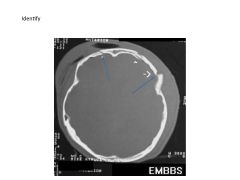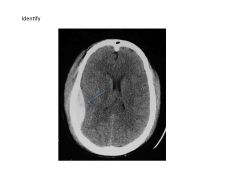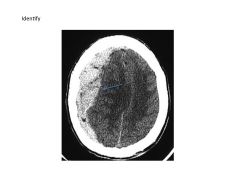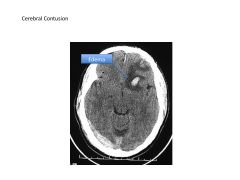![]()
![]()
![]()
Use LEFT and RIGHT arrow keys to navigate between flashcards;
Use UP and DOWN arrow keys to flip the card;
H to show hint;
A reads text to speech;
14 Cards in this Set
- Front
- Back
|
What is a concussion?
|
Transient loss of consciousness; sans structural damage
|
|
|
Linear vs Depressed Skull Fractures
|
Linear: most common; hairline fracture
Depressed: outer cortex bone falls inside skull; sx often req'd to elevate depressed bone |
|

|

|
|
|
Raccoon Eyes vs Battles Sign
|
Raccoon Eyes: peri-orbital ecchymosis suggests frontal basilar skull fructure
Battles Sign: mastoid ecchymosis suggests temporal bone basilar fracture |
|
|
Epidural Hematomas vs Subdural Hematomas
|
Epidural: associated with skull fractures, usually ARTERIAL in origin (Middle Meningeal Artery), may cause LOC then regain consciousness, then LOC again; sx often req'd
Subdural: Result from VENOUS bleeding (usually torn bridging vein going to superior sagittal sinus); worse prognosis; sx intervention usually req'd |
|

|

|
|

|

|
|

|

|
|

|

|
|
|
What is a cerebral contusion?
|
Bruise in the brain; mixture of blood and damaged tissue (intracerebral hematoma = lzn which is dense with blood)
|
|
|
Coup vs Contrecoup
|
Coup = area of impact
Contrecoup = opposite side (where brain shifted and hit) |
|
|
What secondary brain injury is the first to be treated? How?
|
Intracranial HTN:
Ventricular CSF drainage Lower body temp Hyperventilation Diuretic tx (mannitol) |
|
|
What does the Monroe-Kellie Doctrine state?
|
The skull is a rigid and inelastic box
Intracranial contents = blood, brain, CSF An increase in one of these components (or a space occupying lesion) must be compensated for by a decreased in another component or the intracranial pressure will rise |
|
|
What is a high intracranial pressure?
|
Over 20 mm Hg
|

